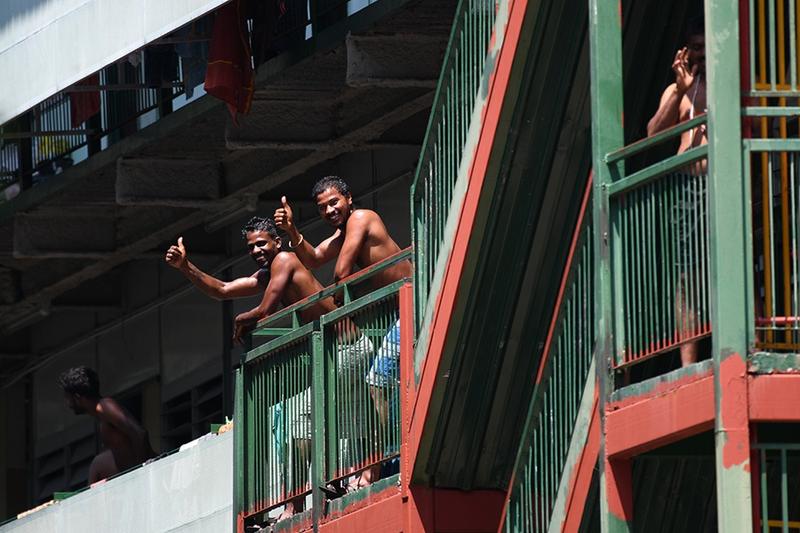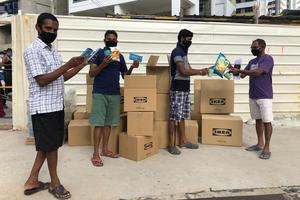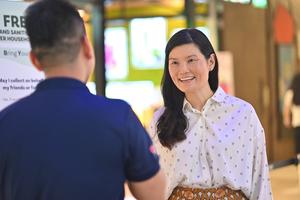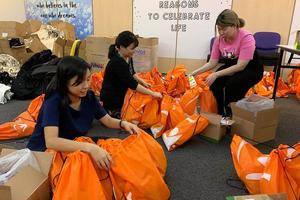City-state and China cooperating closely
 Migrant workers settle into new surroundings at a dormitory transformed into an isolation area to prevent the spread of COVID-19 in Singapore. (ROSLAN RAHMAN / AFP)
Migrant workers settle into new surroundings at a dormitory transformed into an isolation area to prevent the spread of COVID-19 in Singapore. (ROSLAN RAHMAN / AFP)
Editor's note: Nations are collaborating in the fight against the novel coronavirus pneumonia outbreak to limit the damage to people's health and the impact on the global economy. Here, in the eighth part of a series titled "One World, One Fight", we look at how countries can work together.
In just eight hours, Sudesna Roy Chowdhury built a website to translate medical instructions from English into Bengali.
The young trainee doctor, who had no expertise in this field, worked nonstop to ensure frontline healthcare workers could use the site to exchange key information.
The two countries (Singapore and China) have been friends for many years and have gone through good times and difficult situations. This spirit of cooperation and friendship can be the foundation for cooperation at this time
Simon Tay, chairman of the Singapore Institute of International Affairs
She decided to launch it to meet the increasing need for interpreters and translators as the number of migrant workers infected with COVID-19 in Singapore rose.
Chowdhury, a 24-year-old Singaporean, said: "Community members from multiple language groups have also stepped forward to create their own versions (of the site), including those in Tamil, Malayalam, Hindi and Telugu. Many more are in the pipeline."
Morale has improved among Singaporeans, although they are still affected by the health crisis and much work remains to be done, she added.
One email she received stated: "Your (website) will save lives. … On behalf of Singapore, thank you."
Since the city-state reported its first COVID-19 infection on Jan 23, more initiatives such as Chowdhury's have been launched. They target different sectors of society, including the underprivileged, the elderly, healthcare workers, food and beverage outlets, and, most recently, migrant workers.
Melissa Kwee, CEO of the National Volunteer and Philanthropy Centre in Singapore, said, "Singapore has a strong track record of responding generously in times of crisis, but this outpouring of kindness has far exceeded our expectations.
"We have witnessed ordinary people stepping up to meet various emerging needs; from letters of encouragement and care for our tireless frontline workers, to packing and delivering food when there was a shortage of regular volunteers-many of them older Singaporeans with greater (health) risks-to long lines of people donating blood."
Kwee pointed to increased examples of online donations and the emergence of virtual volunteering.
The NVPC manages a national giving platform, Giving.sg, which saw a record-high number of donations during the first nine days of last month after the 3 percent transaction fee was waived and Singaporeans received S$600 (US$422) in a government handout.
In addition, donations in the first four months of this year reached more than S$22.5 million-the highest such figure since the site was launched in 2015.
The NVPC has also set up a portal, SG United Donations-in-Kind, to handle nonfinancial contributions to charities such as Club Rainbow Singapore and the Migrant Workers' Centre.
More than 65 percent of requests have been met by donors from all walks of life-from individuals buying and distributing masks, to multinational corporations donating a range of essential items in bulk.
Kwee said, "We will continue to improve, as we know more about requirements and are working furiously to address them."
 It's Raining Rain Coats, a nonprofit group, helps migrant workers in Singapore receive donations from furniture giant IKEA. (PHOTO PROVIDED TO CHINA DAILY)
It's Raining Rain Coats, a nonprofit group, helps migrant workers in Singapore receive donations from furniture giant IKEA. (PHOTO PROVIDED TO CHINA DAILY)
Noteworthy cause
Many of the grassroots initiatives are aimed especially at supporting migrant workers in Singapore, given the sharp rise in the number of infections among this group in recent weeks.
One of the initiatives, Project Postcard, was launched by 15 alumni from Singapore's School of the Arts, who donated 13 artworks printed on postcards for sale to the public.
The proceeds raised go to projects launched by the Humanitarian Organization for Migration Economics, initially to provide daily essentials and medical aid, and subsequently to support long-term initiatives such as meeting the costs of maintaining a shelter for workers in distress.
Another noteworthy cause is the MaskForce initiative led by Senior Minister of State for Community and Youth Sim Ann.
Face mask kits have been produced and distributed to 650,000 migrant workers and domestic helpers in Singapore with the help of companies, charities and individuals.
Each kit comprises two reusable cloth masks with a filter, as well as a surgical mask. The kits were made and distributed in collaboration with the Migrant Workers' Centre.
The initiative is ongoing and Sim hopes that a second and even a third distribution can be carried out.
"I am deeply grateful for this outpouring of goodwill," she wrote on the portal hosting the donation drive.
Meanwhile, the nonprofit It's Raining Rain Coats, founded in 2015, is engaging directly with migrant workers in Singapore.
 Melissa Kwee, CEO of the National Volunteer and Philanthropy Centre in Singapore, discusses a donation. (PHOTO PROVIDED TO CHINA DAILY)
Melissa Kwee, CEO of the National Volunteer and Philanthropy Centre in Singapore, discusses a donation. (PHOTO PROVIDED TO CHINA DAILY)
Its founder, Dipa Swaminathan, is coordinating at least five projects, including data top-up card donations, and is sourcing English-language teachers to give online tuition.
"I feel our initiatives have responded to the needs on the ground. We are quick to adapt our programs and resources to meet workers' requirements, and our social media outreach is simple, direct and imaginative," Swaminathan said.
"For example, on April 22, a worker messaged us, asking for a carrom board," she said, referring to the popular tabletop game of Indian origin.
"As I was wondering where to source one for him, a member of the public wrote in to say he and his friends wanted to buy and donate carrom boards for the workers."
Healthcare workers have also received a great deal of support, with many of the projects focusing on conveying thank-you messages.
The Singapore Medical Association encourages messages of support and related artworks to be posted on social media, with the hashtag #sgartforhcw.
The artworks selected are displayed in public areas at hospitals to boost healthcare workers' spirits.
More-direct initiatives include GrabCare, which offers a 20 percent discount on private car hire rides to and from work for employees at 14 medical facilities, including the National Centre for Infectious Diseases and Singapore General Hospital.
Efforts have also been made to provide meals for healthcare workers.
Early last month, Singaporean food writer, editor and consultant Annette Tan launched the Our Treat initiative to raise funds to buy restaurant meals for those working in isolation and emergency wards.
"The response has been fantastic. In two weeks, we raised over S$11,000," she said.
"The healthcare workers tell us that they appreciate these gestures and that they are morale-boosters.
"Their workload is unprecedented, so to be greeted at the end of a shift or during a break with a treat like a cookie or a meal from a good restaurant really lifts their spirits.
"What we are doing is by no means large-scale. As you'll see from the amount we've raised, we're not going to save the economy. Our goal is really to foster community spirit while helping to bolster food and beverage businesses."
Tan is also attempting to support eateries that are contributing voluntarily, such as the hawker stall Beng Who Cooks, which is giving away the free meals.
 Staff members from the National Volunteer and Philanthropy Centre prepare aid packages for healthcare workers. (PHOTO PROVIDED TO CHINA DAILY)
Staff members from the National Volunteer and Philanthropy Centre prepare aid packages for healthcare workers. (PHOTO PROVIDED TO CHINA DAILY)
Revenue declines
The food and beverage sector has been affected significantly by the pandemic. The partial lockdown in Singapore means that only takeout services are allowed, and many businesses have seen revenue fall by up to 90 percent.
However, help has been forthcoming.
This month, Bacardi-Martini launched the #RaiseYourSpirits initiative globally, with its brands pledging US$3 million to help bars and bartenders with financial support, meals and other necessities.
In Singapore, the restaurants The Salted Plum and the Barbary Coast provide free meals for the needy.
Siddharth Wazirchand, managing director at Bacardi-Martini Singapore, said, "The current situation has had a significant impact on our long-time partners-from business owners to bartenders-and we are committed to doing what we can to see our industry through this crisis."
Help has also come from unexpected quarters.
Last month, the creative agency Tribal Worldwide Singapore launched the website I Am A CCB(community circuit breaker) in just two days, as a one-stop platform for locals to turn to. "Circuit breaker" is the term used by the government in Singapore to describe the lockdown in the country.
The site includes more than 220 listings, such as where to buy groceries, deals from retailers-some of which are exclusive to the site-and ideas for family activities at home.
A spokesman for the agency said, "We feel that the site has resonated strongly because of local humor and the use of 'Singlish' (Singaporean English). Amid the seriousness of the situation, we just wanted to bring people some laughs."
The site has produced results, with some charity groups reporting a rise in donations after it highlighted their cause.
"For example, we posted about the YWCA's Meals on Wheels program, and they wrote to us saying they had received S$15,000 in just two days from people who saw the post," the spokesman said.
The end of the long road in the battle against COVID-19 in Singapore is not yet in sight and a lot of work remains to be done by all sectors of society.
However, Kwee, from the NVPC, is positive about the outlook. "We can weather (the outbreak) and actively work toward rebuilding a more resilient post-COVID-19 Singapore, where we come together to give our best to ensure no one is left behind," she said.
In recent weeks, infections among migrant workers living in dormitories form the bulk of new cases in Singapore, comprising 98 percent of the total on some days. About 323,000 such workers live in dormitories throughout the island.
Simon Tay, chairman of the Singapore Institute of International Affairs, said, "Case numbers in Singapore are rising, largely because of the urgent and intense effort to deal with the challenge of testing and treating cases in dormitories, where so many migrant workers are housed."
Piotr Chlebicki, a senior consultant at the Department of Infectious Diseases at Singapore General Hospital, responded to criticism that migrant workers have been overlooked.
"There were people (nonprofits who support migrant workers) who were thinking about them, but I am not sure what you could do with 300,000 people living in these kinds of cramped conditions. There was no way, in the short term, to improve the situation," he said.
The Inter-Agency Taskforce, which is managing the outbreak in Singapore, has since adopted strict measures.
For example, it transferred migrant workers-particularly those working in essential services-from the dormitories to other areas, including Singapore Armed Forces camps, floating hotels and vacant public housing blocks.
In an address to the nation on April 21, Prime Minister Lee Hsien Loong gave a pledge to the families of infected migrant workers.
"We feel responsible for their (the workers') well-being. We will do our best to take care of their health, livelihoods and welfare here, to let them go home safe and sound to you," he said.
Agreements with China
When the outbreak emerged in China, Singapore was one of the first countries to respond to a request for personal protective equipment and other medical supplies. It also provided seed money for a humanitarian assistance fund launched by the Singapore Red Cross, which raised more than S$6 million in February alone.
The virtual Singapore-China Joint Meeting on COVID-19, held on April 1, revealed the extent of the close cooperation between the two governments.
Tay, from the SIIA, said, "It featured agreements to exchange views on control and treatment measures, and share good practices related to diagnostics and treatment.
"There was also an agreement to explore the joint research and development of medicines and vaccines.
"Beyond combating COVID-19, both sides agreed to ensure an unimpeded flow of necessary personnel, smooth and open air and sea freight links, and the integrity of supply chains. This is good for all of the region."
It is hoped that regular contact on a government-to-government level and between medical professionals can be maintained to make closer cooperation easier.
Tay added that both countries could work together to provide test kits and other medical supplies for developing countries in the region, while helping them address other issues.
"One avenue would be the establishment of the COVID-19 Response Fund, which was proposed during the ASEAN Plus Three Summit on April 14," he said.
ASEAN Plus Three is the cooperation mechanism between the Association of Southeast Asian Nations and China, Japan and the Republic of Korea.
"Approaching cooperation with a spirit of altruism, in which results are more important than recognition and reciprocity, would ultimately help promote cooperation," Tay said.
"The two countries (Singapore and China) have been friends for many years and have gone through good times and difficult situations. This spirit of cooperation and friendship can be the foundation for cooperation at this time."


